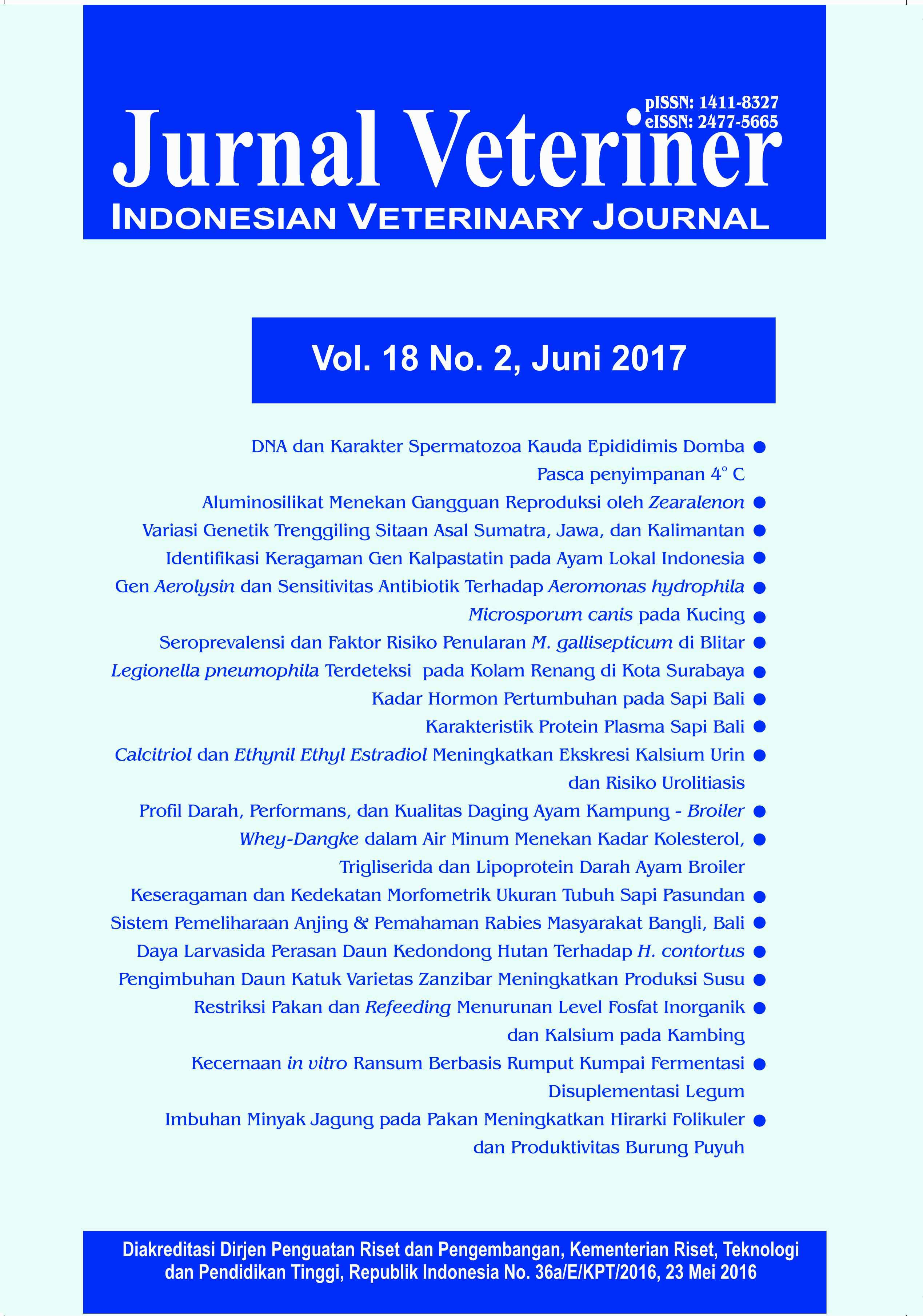Status DNA dan Karakteristik Spermatozoa Kauda Epididimis Domba Pascapenyimpanan pada Suhu 4oC (DNA STATUS AND CHARACTERISTIC OF SPERM CAUDA EPIDIDYMAL RAM AFTER STORAGE AT 4oC)
Abstract
The aim of this study was to evaluate the deoxyribonucleic acid (DNA) status and characteristics of ram spermatozoa, maintained within epididymides stored at 4ºC. A total of 12 pairs of ram cauda epididymis were kept by means that one of the pair in a tube contain media (isotonic NaCl solution) and the other pair into a clean ziplock without medium then stored at 4ºC for three days. Following this, the motility and viability and DNA status of spermatozoa was observed using halomax sperm method, prior and post freezing process. The results showed a decreased in the percentage of motility and viability of spermatozoa from cauda epididymis which were kept in and without media, before or after cryopreservation (P <0.05). Based on the storage method, a significant difference in motility percentage occurs at day two and day three of the storage. Storage using media had a lower percentage of motility (23%; 10%) than without using media (50%; 37%) (P <0.05). The DNA status following storage at 4ºC for three days, descriptively showed impaired of spermatozoa DNA less than 1%. The percentage of impairment increased following the cryopreservation of spermatozoa due to the freezing process. This condition was especially observed on the third day of storage of cauda epididymis which were kept in media (10.16%). The characteristics of spermatozoa from cauda epididymis which were kept in the media were lower compared to without medium. The DNA status of cauda epididymis spermatozoa is not affected by the storage method.
ABSTRAK
Penelitian ini bertujuan untuk mengevaluasi status DNA dan karakterisik spermatozoa asal kauda epididimis domba yang disimpan pada suhu 4ºC. Sebanyak 12 pasang kauda epididimis domba disimpan dengan cara salah satu dari setiap pasang kauda epididimis dimasukan ke dalam tabung berisi media (NaCl fisiologis) dan pasangan yang lain ke dalam ziplock bersih (tanpa media). Penyimpanan dilakukan selama tiga hari pada suhu 4ºC kemudian dilihat motilitas dan viabilitasnya serta status DNA spermatozoa dengan metode sperm sus halomax, sebelum dan setelah pembekuan. Hasil penelitian menunjukkan bahwa persentase motilitas dan viabilitas spermatozoa asal kauda epididimis baik yang disimpan dengan atau tanpa media mengalami penurunan, sebelum atau setelah kriopreservasi (P<0,05). Berdasarkan metode penyimpanan, perbedaan persentase motilitas yang nyata terjadi pada hari ke dua dan ke tiga penyimpanan. Penyimpanan menggunakan media memiliki persentase motilitas yang lebih rendah (23%; 10%) dibandingkan dengan tanpa menggunakan media (50%; 37%) (P<0,05). Status DNA spermatozoa setelah dilakukan penyimpanan pada suhu 4ºC selama tiga hari, secara deskriptif memerlihatkan kerusakan DNA spermatozoa kurang dari 1%. Persentase kerusakan kemudian meningkat setelah kriopreservasi spermatozoa akibat dari pembekuan, terutama pada hari ke tiga penyimpanan kauda epididimis dengan media (10,16%). Karakteristik spermatozoa dari kauda epididimis yang disimpan dengan media lebih rendah dibandingkan tanpa media. Status DNA spermatozoa kauda epididimis tidak dipengaruhi oleh metode penyimpanan.



















